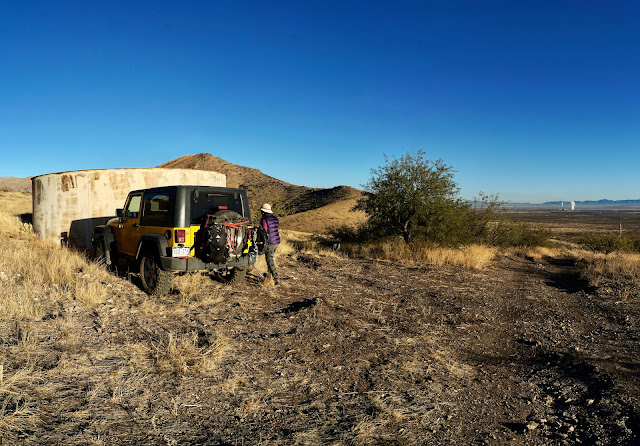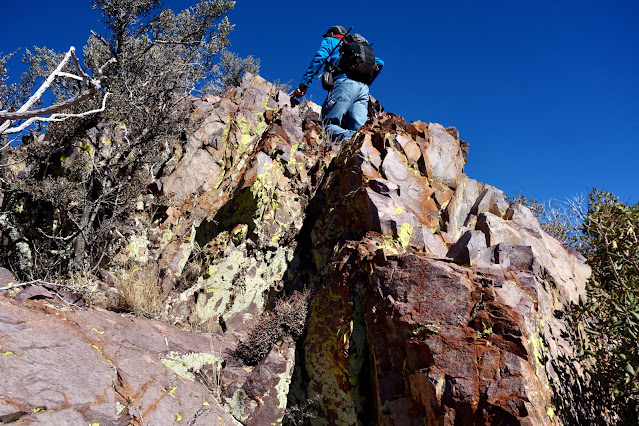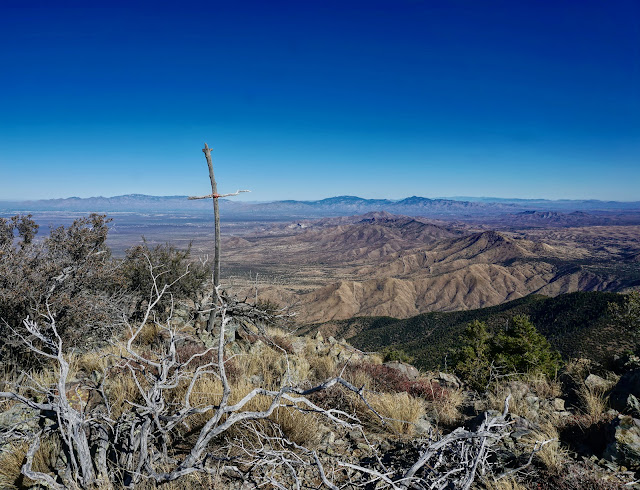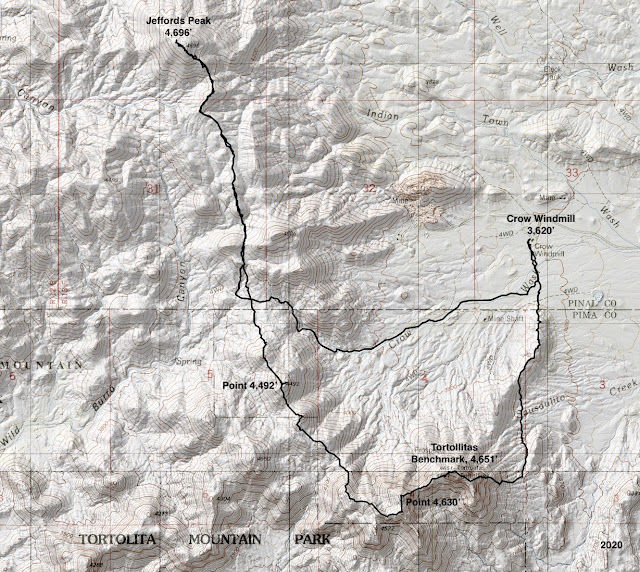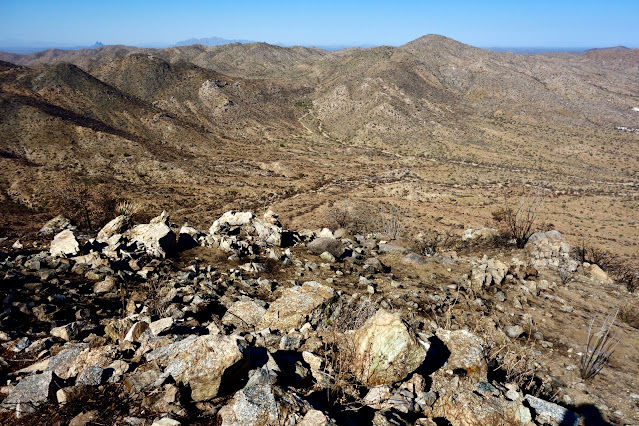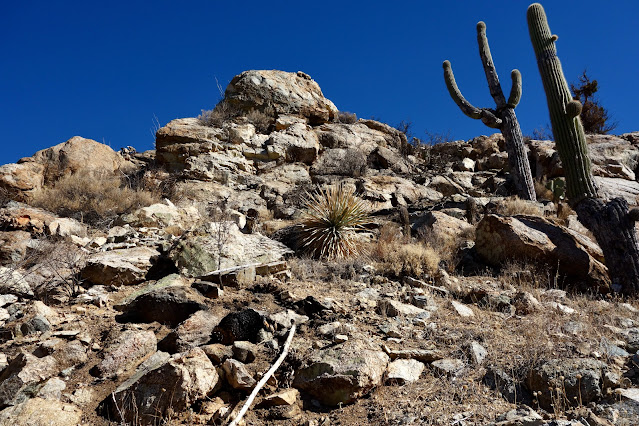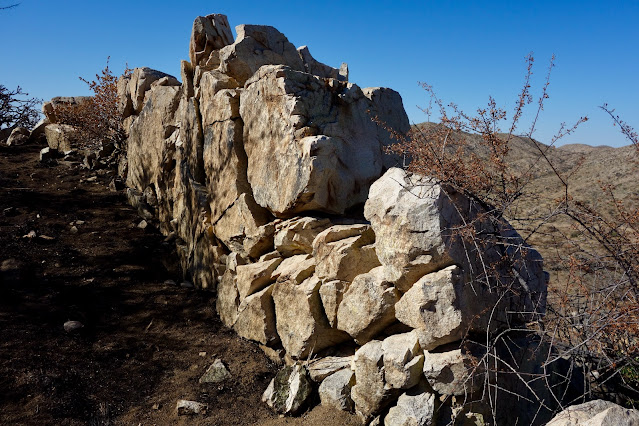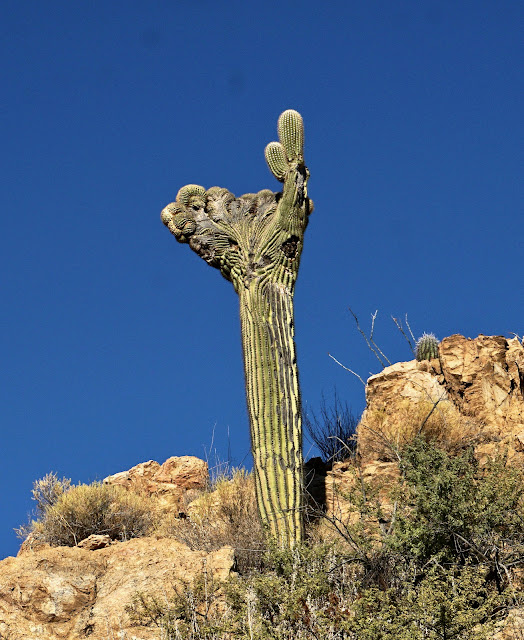Sunday, December 6, 2020
Mount Glenn, 7,519', Dragoon Mountains
Sunday, November 29, 2020
McCleary Peak, 8,357'; Peak 8,853' (88 Mac); Peak 9,146' (Mount Ian), Santa Rita Mountains
Distance and Elevation Gain: 13.2 miles; 4,800 feet of climbing
Total Time: 7:30 to 9:30
Difficulty: Trail, off-trail spurs to peaks; navigation challenging; Class 2+; mild exposure; snow on north-facing slopes shuts this hike down for the season; dress defensively; springs are intermittent so carry all the water you will need.
Map: Mount Wrightson, Arizona 7.5' USGS Quad
Date Hiked: November 29, 2020
Poem:
I feel the inescapable pull of the earth
the deep old Earth pulling me back to her.
But now as the changeable colors of days
wheel with increasing velocity past my sight
these eyes of mine grow steadier,
my heart grows stronger,
and from the deep old Earth I know knowledge of things,
wonderful things I could never have known before. Maynard Dixon
The Approach
There are multiple approaches to McCleary Peak including the Florida Canyon and Bog Springs trails. This is the most
efficient route for those doing the full loop. From the trailhead, elevation
5,420 feet, walk east on the Super Trail alongside an unnamed tributary of
Madera Canyon through a forest featuring alligator juniper. The chunky stone on
the footpath mimics the surface on the Old Baldy Trail. The
lower mountain is composed of a crystalline igneous granitic. At 0.3 mile, cross the creek on a left hook. It was running dry in late autumn but this stream and
the next two are capable of carrying large volumes of water so use caution.
Unobstructed in the west are forested Pete Mountain, thrusting Elephant Head, and the granite monolith without rival, Baboquivari Peak.
The north spur to McCleary leaves from its saddle with 88 Mac at 4.2 miles, 8,140 feet. I know plenty of people who only climb legal summits. With a prominence of 217 feet, this one doesn't make the 300-foot cut. Do not deny yourself this delightful experience. It is only a quarter mile to the far north crest of the Santa Ritas. Locate a social trail in the grass on the other side of the log, shown. The scant path barges up through shrubs and outcrops. In 2020, there were no cairns but the trail helps immeasurably. In its wild state this climb would be difficult.
The Four Springs Trail ends at the Crest Trail at 5.5 miles. This is 200 feet above Florida Saddle on the northeast ridge of 88 Mac. Turn south on this boot-worn passageway and ascend gradually and consistently. At one dramatic place the trail tracks along a cliff face that insists on being touched. Arrive on the north crest ridgeline once again at 8,540 feet, 6.2 miles. From the grassy flat expanse the second peak is 0.8 mile roundtrip with a rise of 313 feet. Walking north, sporadic cairns guide as you enter the rock.
Friday, November 27, 2020
Tortollitas Benchmark, 4,651', and Jeffords Peak, 4,696', Tortolita Mountains
Essence: The relatively low-slung Tortolita Mountains are located
northwest of Tucson in the wedge between I-10 and AZ-77. The two tallest peaks
in the range are located north and east of the popular trail system in
Tortolita Mountain Park. This stem and loop in the "little turtle dove"
mountains links Tortollitas Benchmark (note the variant spelling) via a
lengthy ridgeline traverse with Peak 4,696', unofficially but commonly
referred to as Jeffords Peak. The ridge is suspended above Oro Valley with
superb views of the Santa Catalina Mountains. We did this hike of solitude
during the COVID-19 pandemic and did not see a person or even a footprint. Be
advised that the Tortolita Fire in June, 2020, scorched the earth and
incinerated plants on broad swaths of this route. The hike is primarily on
Arizona State Trust Land with a slice of Bureau of Land Management property
surrounding Peak 4,651'.
Travel: This route begins from
Edwin Road in Oro Valley. For those coming from Tucson, drive north on AZ-77
(Oracle Road) to the signal at Eagle Crest Ranch Blvd. This is 12.8 miles
north of the Ina Road and Oracle Road intersection. Edwin Road is slightly
offset, just south of the signal. Hang a U-turn and make an immediate jog onto
Edwin Road heading west. Enter Rail X Ranch, a grazing lease on Arizona State
Trust Land. 4WD with high clearance is helpful on this primitive dirt, sandy,
bumpy and rocky road as it barges through the Sonoran. Go through a white
wooden gate and cross a cattle guard 5.2 miles from AZ-77. Make an immediate
left to a large parking lot at Crow Windmill, 5.4 miles.
Distance and Elevation Gain: 9.1 miles; 2,900 feet of climbing
Total Time: 6:00 to
7:30
Difficulty: Primarily off-trail; navigation challenging;
Class 2+; no exposure; steep slopes; carry all the water you will need and
avoid on hot summer days; dress defensively.
Maps: Ruelas
Canyon; Tortolita Mountains, AZ 7.5' USGS Quads
Permit: Post an
Arizona State Trust Land permit in your vehicle.
Date Hiked: November 27, 2020
Quote: By forces seemingly antagonistic and destructive, Nature accomplishes her
beneficent designs - now a flood of fire, now a flood of ice, now a flood of
water; and again in the fullness of time an outburst of organic life..."
John Muir
Route: There are multiple routes up both mountains. We devised this route on the fly and I can only confirm that it worked well for us. From Crow Windmill we went south to the east ridge of Tortollitas Benchmark. From the peak, we followed the ridge as it swung west and then north to Jeffords Peak. We retraced our steps to the Wild Burro+Ridgeline mountain bike track and took it east to Crow Wash and the windmill. Note: the Tortolita Mountain quad has 40-foot intervals and the Ruelas Canyon map has 20-foot intervals.
You will get a good layout of this hike while driving west on Edwin Road. Below, Tortollitas Benchmark is on the left and Jeffords Peak, the highest point in the range, is the softly rounded dome on the right.
Crow Windmill, elevation 3,620 feet, was an active place. The windmill turned earnestly and made an eerie singing sound. The graffiti splattered tank was brim full and cattle grazed nearby.
Tortollitas Benchmark, Peak 4,651'
Our intention was simply to climb the benchmark having seen this intriguing peak from Oracle Road over the years. We got a good visual of the mountain from the parking area and planned our approach from there. The north face looked too steep so we discarded that idea. We decided on the east ridge which turned out to be steep enough in its own right. It was a good choice from a ridge purist standpoint. The northwest ridge may have a shallower incline but we can't confirm the viability of that route. We headed south and crossed Crow Wash, an OHV thoroughfare. On this day, all was silent and still. We ascended a minor ridge, image-left.
Weave around and plow through a typical Sonoran mix of mesquite, soap tree yucca, palo verde; barrel, hedgehog, and assorted cholla cactus; ocotillo, and saguaro. The Hohokam occupied this area from approximately 500 to 1200 CE. We happened by a grinding stone on a gray boulder at the base of the ridge.
Rise up through igneous granite and diorite boulders embedded with quartz chunks. The walking surface throughout the hike is crushed granite. From the first knob, only a few hundred feet off the Oro Valley floor, the view already captivates. Cattle and burro trails assist while crossing shallow ravines. We went up a stone passageway in the swale, image-left.
Begin the east ridge climb at 1.4 miles, 3,900 feet. Footing is marginal as the mountain pitches up in earnest with loose soil and stones, and seated bedrock. We made for the largest perched boulder on the skyline.
The fire burned with a vengeance on the upper mountain. Step through ash and charcoal in the pocket to the left of the target boulder.
Top out on the mellow summit ridge and do a light Class 2+ scramble to the crest at 1.8 miles after 1,100 feet of climbing.
We searched for the benchmark placed by the USGS in 1903! The little disk was still on the mountain in 1967 when surveyors checked. Lamentably, it has since gone missing. Nothing stands in your way of a fabulous view of mountain ranges splaying out like a pin wheel. Jeffords, afar to the northwest is only 45 feet superior. Our goal to visit the benchmark met, Jeffords wasn't even on our radar. But we were enticed by the convoluted ridge between the two mountains and decided to follow it just for fun. With each successive roller topped, linking the peaks seemed ever more plausible.
The first prominence to the west is subsidiary Point 4,630'. Downclimb through a Class 2+ cliff band.
This image looks back up at the fire-scared boulder-enhanced slope.
There are two knobs between Tortollitas Benchmark and Point 4,630'. Flank the first on the north and climb up and over the next. From the saddle at 4,410 feet, the climb is moderately steep with good footing. Mount the roller at 2.2 miles and then crank briefly south, following the ridge. This image was shot on the southbound segment. On the horizon is Peak 4,416' in Tortolita Mountain Park. It is a big pile of spheres and a joy to climb.
The Westridge, Edwin, Dove, and Tortolita fires burned in the range in the summer of 2020. The largest, the Tortolita Fire, was ignited by a lightning strike in June and incinerated 3,140 acres. The fire was spotty in places, and elsewhere did serious damage. Little rain has fallen since and recovery is minimal thus far. (THW, photo)
Some of the undulations on the ridge are pretty radical as it swings north-northwest. From Point 4,630', give up over 500 feet while bouncing over four knolls and then climb Point 4,492', shown. Along the way thread through spheroidal boulders and pass by gigantic piles of wild burro scat. We saw fresh hoof prints and whiffed their scent but the animals remained out of sight.
There is a dramatic white outcrop and cairn on Point 4,492' at 3.4 miles. From there we could see the mountain bike trail going over the ridge linking Wild Burro Canyon and Crow Wash. With an easy exit in our future, we decided to go for Jeffords Peak. The day was short so we plotted the most direct route, over the saddle (image-center) west of Point 4,526', image right.
Stacked white blocks on the north slope of Point 4,492' may be a Hohokam defensive wall. Descend to the Ridgeline + Wild Burro mountain bike loop trail at 4.0 miles, 4,140 feet.
Jeffords Peak, 4,696'
The highpoint of the Tortolita Mountains is 1.5 miles afar. We figured out the route as we hiked and it turned out to be the most direct, taking 50 minutes each way. Make for the east-west saddle, staying west of the initial ravine. Watch for a crested saguaro on the hillside to the west. From the saddle, drop into a west trending swale and then up onto a low ridge, image-center.
The landscape is chaotic with random knolls in unexpected places. Simply stay on the north bearing ridge. Mount Lemmon dominates over this humble range and its retired chalk mine. (THW, photo)
The complicated approach is over at 4,420 feet. The bastion exudes a nobility with white crystalline blocks girdling the mountain and floating down the rounded southeast ridge.
Crest Jeffords Peak at 5.5 miles. Judging from the summit register, this mountain sees slightly more traffic than the benchmark with periodic visits from the Saddlebrook Hiking Club. A brief history of Tom Jeffords is found in a HikeArizona post. "Tom Jeffords was a U.S. Army Scout, Indian agent, prospector, and superintendent of overland mail in the Arizona Territory. Tom was best known for his friendship with Cochise and ending the Indian wars in Arizona. Because of this, he was one of the few settlers allowed to travel freely through Indian territory. After several business ventures, he settled in the Tortolita Mountains and died at Owl Head Butte in 1914."
Retrace your path back to the mountain bike trail. From there, it is a fast two mile downhill glide back to Crow Windmill. This image renders a good look at the appealing northwest ridge of Tortollitas Benchmark. (THW, photo)
Be alert for the remarkable crested saguaro on the hillside north of the trail just before Crow Wash. Stay on the old fire road as a single track wanders to-and-fro. Actually, there are multiple threads of roads spinning off the wash so it can be a little confusing. Bear east and watch for the windmill. Eventually, you must leave the wash and walk north to your vehicle. (THW, photo)


